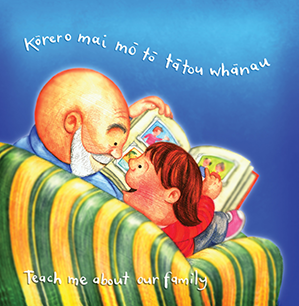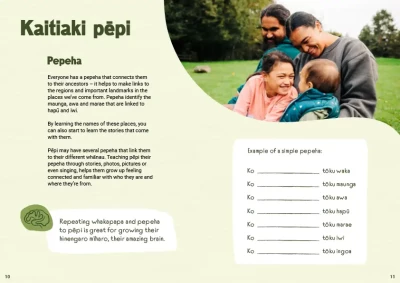
Familiar people and things photo book
A photo book allows baby to make connections with the people who care about them.
Book sharing provides a rich (multi-sensory) learning experience for baby, and it’s a way for them to spend quality time with mum and dad.
A family photo book has the added opportunity of helping baby to make links with pictures of familiar people and things. In Whakatipu Te Pihinga 2 (page 10), we can see that the photo book could be the beginning of helping baby learn about who they are connected to and and where they belong.
Familiarity and permanence
Familiar pictures are especially valuable during this stage, when a baby is developing object and person ‘permanence’. This is when they understand that something (or someone) still exists when they can’t be seen.
With this new stage of development, baby’s brain can now create an internal picture of something that they can’t see.
Person permanence is linked to the attachment relationship that’s formed between baby and their primary caregiver – a person who is central to their safety and security. They may become upset when they suddenly can't see this important person.
Ask the whānau:
- Have you noticed baby getting upset if you (or the primary caregiver) leave the room?
Sometimes parents might think baby has become ‘clingy’ and see this development negatively. Instead, help them celebrate the secure attachment they’ve formed with their baby.
Preparing for separation anxiety
Talk with whānau about any appointments or engagements coming up that will involve baby being around strangers, for example, a visit to the doctor.
Also, help mum and dad think about those times that might require them to be separated from baby for a short period, for example, for a job interview or a medical examination.
What could you do to avoid baby getting too stressed when you're away?
Try an activity
Family photo book
Encourage whānau to make their own photo books to share with pēpi. Whānau may have photos stored that they could use to make a family photo book.
Baby will likely want to explore the photos ‘fully’ (with hands, eyes and mouth). So it’s probably best for them to have their own book – rather than dad or mum’s phone.
- Have you shown family photos to baby?
- Have they seen them on a device or in an album?
Suggest that if they don’t have any family photos, then they could use magazine pictures of familiar things, pets, toys, vehicles or places. They only need a few pictures to start with and can add to them as time goes on.
Small inexpensive ‘brag books’ can work for this activity as it lets baby explore them without ripping or ruining them.
Several plastic zip lock bags with pictures slipped inside can also work well – this way the photos can be mouthed without baby damaging them.
Enjoy the book together
Encourage whānau to sit together with baby and share these books often – they’ll soon become one of baby’s favourites.
Encourage whānau to think about:
- who’s in the photos
- where the photos are taken
- who baby knows in the photos
- what they would like baby to know about these people, places or things
- what happens if they point to someone they know and say their name.













